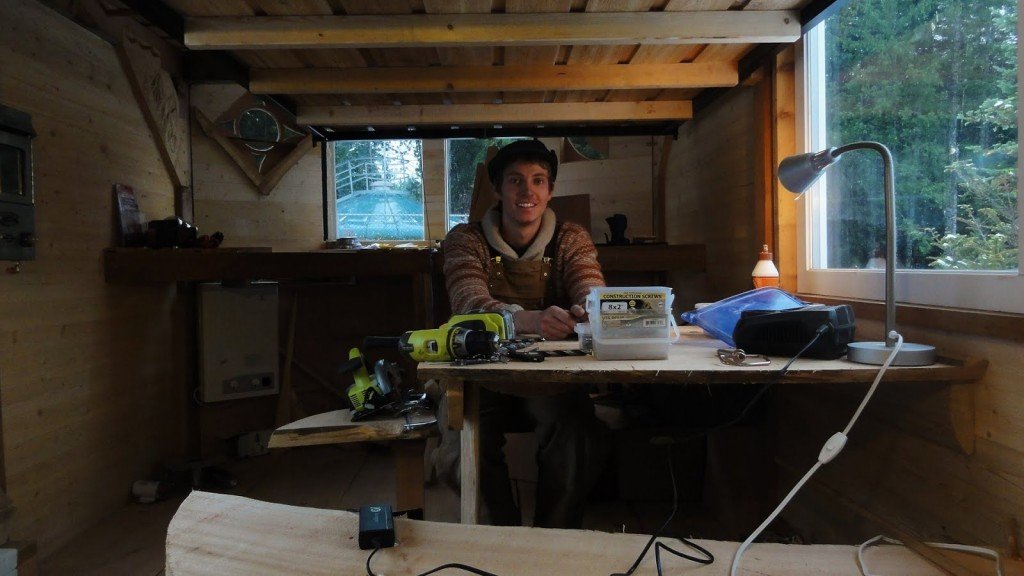
By Bella Tsefalas
Published: April 20, 2013
The off grid homes presence in Squamish remains a mystery until one accidentally bumps into a small community of cabins on a hike, or on a backcountry expedition into Garibaldi Park.
People seem to find their homes in the same manner.
Since 1998, Lisa Bjornson, general manager at Black Tusk Realty, has lived with her husband off the grid in the Ring Creek community.
By some stroke of luck, the family won the property in a Poker game. The only catch was that they needed to build some type of structure or dwelling on it within a year.
Thus, the couple began work on their long-term home.
Because Ring Creek is located directly on the back of the Diamond Head area of Garibaldi Provincial Park, the land is owned by the province.
There are about 18 full time residences in the Ring Creek area.
Instead of clear-cutting the space for their home, the Bjornsons selectively cut around it and fit the home into the space, even building their deck to accommodate a single tree.
Once they settled on the property, they had to set up alternative power systems. There are two primary ways to power an off the grid house: micro hydro and solar power.
Lisa chose the Micro Hydro system, a system that thrives in places like coastal British Columbia, where creeks and other water resources are easily accessible.
The micro hydro system works when a certain amount of water from the running stream creates pressure to spin a wheel. The spinning wheel sends the Direct Current (DC) to the house’s battery bank.
The home’s logic centre (a bank where all sources of power connect, which all alternative homes have) then pulls DC power out of the batteries and converts it to alternating current (AC), which is present in the house.
Lisa’s micro hydro system feeds off this stream for around 8 months of the year, as the other four bring either drought or ice.
Fortunately, for the Bjornsons, a glacial stream runs straight through their property, making micro hydro power possible.
Often, properties don’t have connections to commonly used technology like internet and cell phone reception.
The Bjornsons house is armed with candles and flashlights.
It’s a neighbourhood where people drive around with chainsaws in their cars in case a tree falls down, she says.
Off-grid living also calls for constant preparation.
Finding the right type of land to accommodate basic living needs is a challenge.
Buying the land and setting up the power systems are more expensive than moving in to a pre-constructed home on the grid. Upkeep also takes extra time and money.
For Eric Carlberg and Sara Kuitunen, weathering through the rough patches of off-grid living brought them closer.
Eric and Sara came to Squamish individually, but found each other through their obsession with the rock climbing and backcountry skiing.
Taking full advantage of Squamish’s rugged, outdoorsy side, the couple made the big move to a renovated train caboose deep in the woods of Paradise Valley.
The caboose took a decade to renovate.
Renovated by Jon Ave, it’s is well submerged in the nature around it. Aven used a tree branch from right outside to make the dining table, and the drawers were made from a single piece of wood from the area.
He also built a giant deck surrounding the caboose, to extend the floor space of the home. A tree house and an outdoor shower are hidden nearby as well.
“It’s quite a magical place,” the couple say.
Though aesthetically pleasing, building codes and power shortages often intercepted the peaceful lifestyle.
An antique wood burning stove was a prominent component of the caboose’s rugged style, but the landlord could not insure the house with it, as it wasn’t up to code.
So, the couple was forced to heat the place with propane, which involved excessive labour. Then, there is the transportation issues of unkept and gravel roads.
But all this has also brought the two together.
“It’s a very warm, beautiful experience to be in such a place with someone you love,” says Eric.


Tanys says
I live in ring creek I need help with my micro hydro system. Rebuilt alternator but now I don’t know how to hook back up and ensure it is working right
Any help available for an ol girl